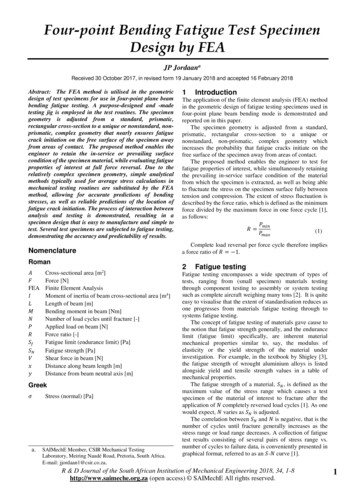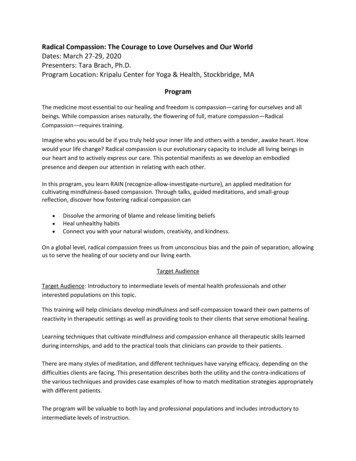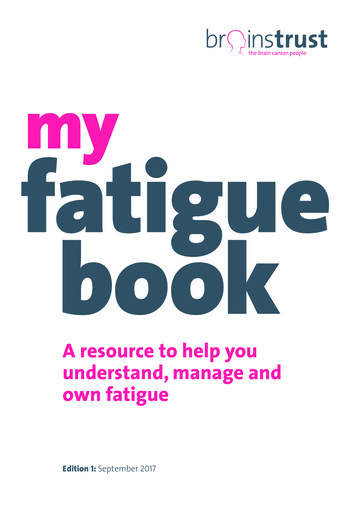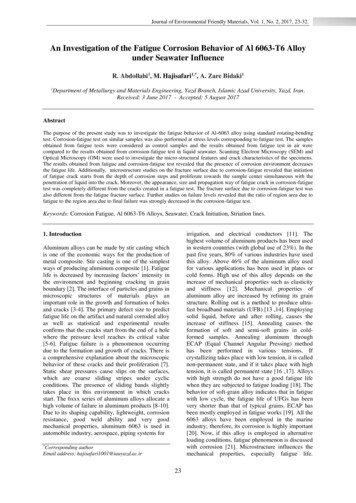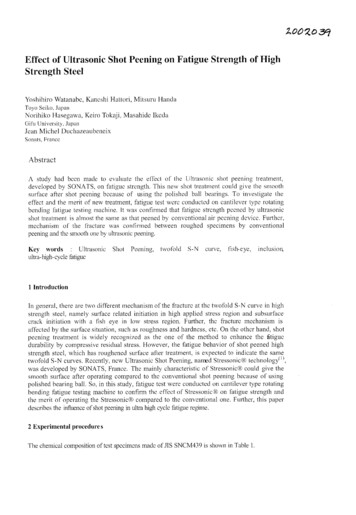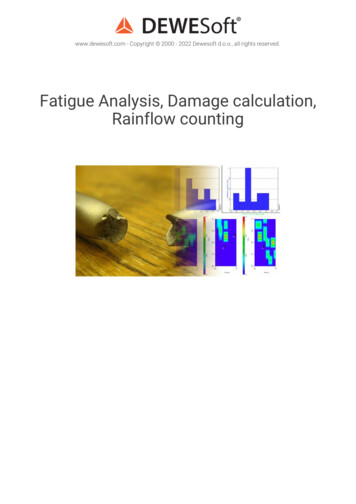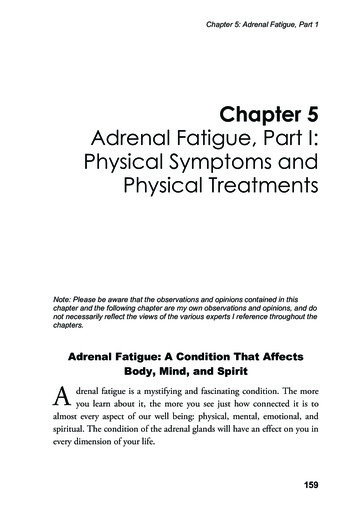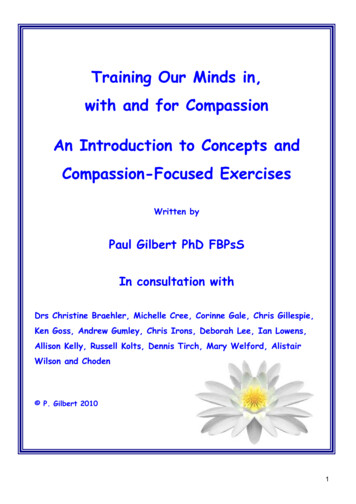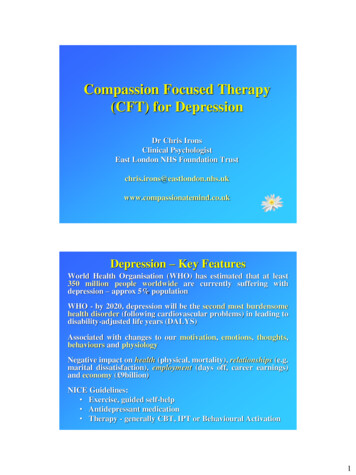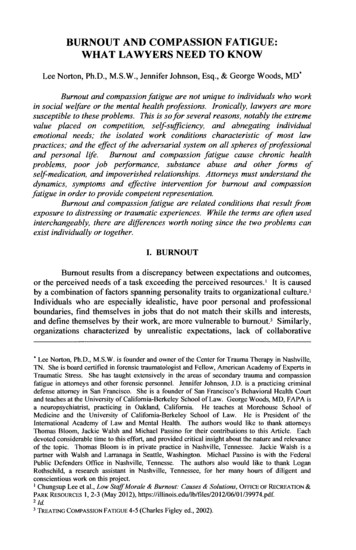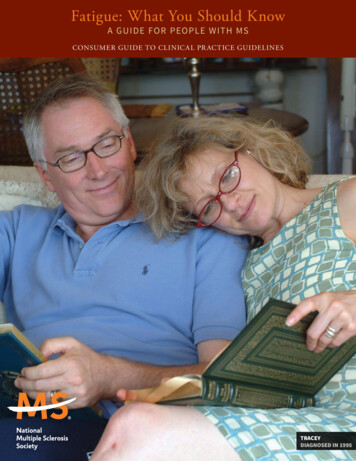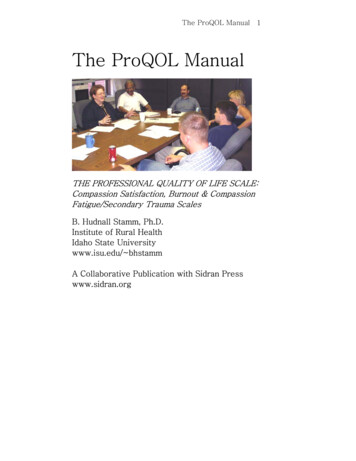
Transcription
The ProQOL Manual 1The ProQOL ManualTHE PROFESSIONAL QUALITY OF LIFE SCALE:Compassion Satisfaction, Burnout & CompassionFatigue/Secondary Trauma ScalesB. Hudnall Stamm, Ph.D.Institute of Rural HealthIdaho State Universitywww.isu.edu/ bhstammA Collaborative Publication with Sidran Presswww.sidran.org
The ProQOL Manual 2Acknowledgements for their faithful contributions to the development ofthe ProQOL go to Joseph M. Rudolph, Edward M. Varra, Kelly Davis,Debra Larsen, Craig Higson-Smith, Amy C. Hudnall, Henry E. Stamm,and to all those from around the world who contributed their raw data tothe databank. I am forever indebted to Charles F. Figley who originatedthe scale, and in 1996, handed the scale off to me saying “I put asemicolon there; you take it and put a period at the end of the sentence.”No one could have wished for a better mentor, colleague, and friend. BHSCopyright B. Hudnall Stamm, 2005, all rights reservedPublished under a joint agreement with Sidran Press.This material may be freely copied as long as (a) author is credited, (b) nochanges are made, & (c) it is not sold except for in agreement specificallywith the author.
The ProQOL Manual 3Table of ContentsTopicI. IntroductionII. Scale DefinitionsCompassion SatisfactionBurnoutCompassion Fatigue/Secondary TraumaLanguages AvailableIII. Scale Creation MethodsIV Psychometric InformationScale Distributional PropertiesReliabilityValidityWork Type ComparisonsV. ScoringCompassion SatisfactionBurnoutCompassion Fatigue/Secondary TraumaCut ScoresVI. Missing DataVII. Manual ReferencesVIII. BibliographyPublications about Various Versions of theProQOL (Including the CFST and the CFS)Publications on the Construct of CompassionFatigue/Secondary Traumatic Stress/VicariousTrauma Professional Quality of LifeGeneral Reference List for Construct ofCompassion Fatigue/Secondary TraumaticStress/Vicarious Traumatic StressVIV. Frequently Asked QuestionsPage4455567778910111212121314151716181924
The ProQOL Manual 4THE PROFESSIONAL QUALITY OF LIFE SCALE: CompassionSatisfaction, Burnout, and Compassion Fatigue/Secondary TraumaScalesI. INTRODUCTIONThe Professional Quality of Life Scale (ProQOL) is the current version of theold Compassion Fatigue Self Test (Figley, 1995). This version and the namechange emerged for two reasons. First, the original scale has knownpsychometric problems. Second, we chose to change the name because werealized after market testing, that focusing the overall effort toward a positivething, professional quality of life, made it easier to support positive systemchange to prevent or ameliorate the negative effects of caregiving and buttressthe positive effects of providing care.Multiple versions of the Compassion Fatigue test (CFST or CSF, Figley,1995; Figley & Stamm, 1996) have been widely used in assessing compassionfatigue or secondary/vicarious trauma. Subscale psychometric difficultieshave been noted (Figley & Stamm, 1996; Jenkins & Baird, 2002; Larsen,Stamm, & Davis, 2002). The ProQOL is a third revision of the CSF. Thisrevision addresses difficulties separating burnout and secondary/vicarioustrauma and reduces participant burden by shortening the test from 66 to 30items. The revision, based on over 1000 participants from multiple studies,was developed by retaining the strongest, most theoretically salient items.Specifically, items were retained if they met both high item-to-scale criteriaand were theoretically good representatives of the subscale construct.Quantitative decisions were made using Chronbach’s alpha, factor analysis,and multigroup factorial invariance. Each new subscale has 10 items: 7 itemsfrom the previous CSF version and 3 new items designed to strengthen theoverall theory of the subscale. New items were developed from the mostrecent literature on burnout and theory relating to compassion satisfaction.The ProQOL now consists of three subscales: Compassion Satisfaction,Burnout, and Compassion Fatigue. Initial data suggest that these subscaleshave excellent internal consistency.II. SCALE DEFINITIONSThe ProQOL is composed of three discrete scales that do not yield acomposite score. Each scale is psychometrically unique and cannot becombined with the other scores. Considerable work has been undertaken tocreate a composite indicator score but to date, no satisfactory arrangement hasbeen discovered. The key reason for this is the complex relationship between
The ProQOL Manual 5the scales. It is possible for people to report high scores on CS combined withhigh scores on CF; this is not atypical among those who retain their altruisticdesire to help when working in distressing situations such as in war or refugeecamps. Typically, we do not see high scores on burnout with high satisfaction,but there is a particularly distressing combination of burnout with trauma.These latter cases seem to be at the greatest risk for negative outcomes,including, but not limited to, depression or PTSD and bad professionaljudgment which may contribute to patient care error or poor administration.Compassion Satisfaction: Compassion satisfaction is about the pleasure youderive from being able to do your work well. For example, you may feel likeit is a pleasure to help others through your work. You may feel positivelyabout your colleagues or your ability to contribute to the work setting or eventhe greater good of society. Higher scores on this scale represent a greatersatisfaction related to your ability to be an effective caregiver in your job.Burnout: Most people have an intuitive idea of what burnout is. From theresearch perspective, burnout is associated with feelings of hopelessness anddifficulties in dealing with work or in doing your job effectively. Thesenegative feelings usually have a gradual onset. They can reflect the feelingthat your efforts make no difference, or they can be associated with a veryhigh workload or a non-supportive work environment. Higher scores on thisscale mean that you are at higher risk for burnout.Compassion Fatigue/Secondary Trauma: Compassion fatigue (CF), alsocalled secondary trauma (STS) and related to Vicarious Trauma (VT), is aboutyour work-related, secondary exposure to extremely stressful events. Forexample, you may repeatedly hear stories about the traumatic things thathappen to other people, commonly called VT. If your work puts you directlyin the path of danger, such as being a soldier or humanitarian aide worker, thisis not secondary exposure; your exposure is primary. However, if you areexposed to others’ traumatic events as a result of your work, such as in anemergency room or working with child protective services, this is secondaryexposure. The symptoms of CF/STS are usually rapid in onset and associatedwith a particular event. They may include being afraid, having difficultysleeping, having images of the upsetting event pop into your mind, oravoiding things that remind you of the event.
The ProQOL Manual 6Languages Available: The ProQOL and its predecessors have been used inprojects in more than 30 countries around the world. It is available in English,French, Spanish, German, and Hebrew. Other translations are invited.The ProQOL is used across many different types of professions. Sometimes itis appropriate to change the word helper to one that is more specific for thegroup being tested. For example, if you are working with teachers, you mightchoose to replace helper with the word teacher. This change can be madewithout specific permission from the test developer.
The ProQOL Manual 7III. SCALE CREATION METHODSThe revision was based on a database of 365 cases from the original measureknown as the CFST (Figley, 1995; Stamm & Figley, 1996), 940 cases fromthe “middle revision” known as the CSF (Stamm, 2002) and 463 cases usingthe current revision, the ProQOL. The data are amalgamated from separatestudies. Data are aggregated by type of participant group (e.g., therapists,teachers, nurses, humanitarian aide workers, etc.). Because it is difficult toobtain information about the sex of the participants, data are not analyzed formale/female differences, although multiple previous studies have not yieldedsex differences on any of the subscales. The psychometric data reported hereare from an entirely new sample of 463 people taking the ProQOL.The revised version was developed by retaining the strongest, mosttheoretically salient items and bolstering the subscales with new items to bestrepresent their respective constructs. Specifically, items that met both highitem-to-scale criteria and were theoretically good representatives of thesubscale construct were retained. Quantitative decisions were made usingChronbach’s alpha, item-to-scale analyses, common factor analysis, andmultigroup factorial invariance. Each new subscale has 10 items: 7 items fromthe previous CSF version and 3 new items designed to strengthen the overalltheory of the subscale. New items were developed from the most recentliterature on burnout and theory relating to compassion satisfaction.The overall length of the measure dropped from 66 to 30 items. The threesubscale structure was retained—Compassion Satisfaction, Burnout, andCompassion Fatigue/Secondary Traumatic Stress. In order to reflect thechanging nature of the construct, which includes positive as well as negativeitems, the measure was given a new name, the Professional Quality of LifeScale, or the ProQOL. The measure, psychometric information, and scoringkey is located at www.isu.edu/ bhstamm.IV. PSYCHOMETRIC INFORMATIONScale Distributional Properties: The scales generate distributions that aregenerally unimodal and symmetric (figure 1). The Compassion SatisfactionScale typically is skewed toward the positive side and the compassionfatigue/trauma is skewed toward the absent side (e.g., most people report littledisruption).
The ProQOL Manual 8Figure 1: Subscale Distributional PropertiesMeanMedian ModeSDS Error SkewKurtosi MinsMaxCS3738397 .3.3 4-.881 .7 7350BO2222216 .8.3 1.0 7-.35340CF/STS 1312156 .3.2 9.6 6.4 3237Compassion SatisfactionBurnout140Compassion Fatigue/Traumatic Stress10010012080801006080606040Mean 37.0N Std. Dev 6.75Mean 22.3N 027.525.032.530.037.535.040.0FrequencyStd. Dev 7.2920FrequencyFrequency404020Std. Dev 6.33Mean 13.0N .530.037.535.0TRAUMAReliability: The alpha reliabilities for the scales are as follows (see figure 2):Compassion Satisfaction alpha .87, Burnout alpha .72 and CompassionFatigue alpha .80. While these are in absolute value somewhat lower thanthe original test (Compassion Satisfaction alpha .87, Burnout alpha .90,Compassion Fatigue alpha .87), given that the scales are shortened by halfin length, these scores are actually more reliable than the longer form (seeSpearman Brown formula, for example, if original reliability was .82, acomparable reliability on the shortened scale would be .69). The measure hasconsiderable improvement on the item-to-scale statistics due to increasedspecificity and reduced colinearity. In addition, the standard errors of themeasure are quite small so that the test typically has less error interferenceimproving the potential measurable effect size. This latter point is particularlyimportant with the sample sizes common among small clinical studies. Earlyreturns on test-retest data suggest good reliability across time with a smallstandard error of the estimate.Comment: Does not match value inFigure 2 (.71 vs .72). Text uses .72 in alldocuments.
The ProQOL Manual 9Figure 2: Alpha factionBurnoutCompassionFatigue/ SecTraumaticStressBurnoutCompassionFatigue/ SecTraumaticStressalpha .89n 457alpha .71n 379alpha .80n 369See also:Larsen, D., Stamm, B.H., & Davis, K. (2002). Telehealth for Prevention andIntervention of the Negative Effects of Caregiving. Traumatic StressPoints,16(4). alth.htmFigley, C.R., & Stamm, B.H. (1996). Psychometric Review of CompassionFatigue Self Test http://www.isu.edu/ bhstamm/pdf/figleystamm.pdf. In B.H.Stamm (Ed), Measurement of Stress, Trauma and Adaptation. Lutherville,MD: Sidran Press. http://www.sidran.org/catalog/stms.htmlStamm, B.H. (2002). Measuring Compassion Satisfaction as Well as Fatigue:Developmental History of the Compassion Fatigue and Satisfaction Test. InC.R. Figley (Ed.). 107-119, Treating Compassion Fatigue. New York:Brunner Mazel.Validity: The construct validity upon which the test is based is wellestablished with over 200 articles noted in the peer-review literature (seeStamm, 1999 or www.isu.edu/irh bhstamm for bibliographies). Using themulti-trait multi-method mode for convergent and discriminant validity(Campbell & Fiske, 1959), the scales on the ProQOL do, in fact, measuredifferent constructs. In addition, the ProQOL revision of the CFST reducedthe known colinearity between Compassion Fatigue and Burnout. The interscale correlations are as small. Compassion Satisfaction has 5% shared
The ProQOL Manual 10variance with Burnout and 2% shared variance with CompassionFatigue/Trauma. The shared variance between Burnout and CompassionFatigue/Trauma is somewhat higher, likely reflecting the distress that iscommon to both conditions (21%), but the two scales are clearly different (seefigure 3). Studies of discriminant and convergent validity are underway byseveral doctoral students at multiple universities.Figure 3: Convergent and Discriminant Validity Among ue/ SecTraumaticStressCompassionSatisfactionBurnoutR -. 2 3c o -σ 5 %CompassionFatigue/ SecTraumaticStressR -. 1 5c o -σ 2 %R -. 4 6co-σ 21%Work Type Comparisons (Figure 4 & 5): To date, three broad classes ofworkers have been tested: general health workers (including cliniciansthrough administrators); child/family workers, including residential and childprotective care workers; and school personnel, which includes teachers,counselors, and administrators. Teachers were significantly more satisfiedwith their work, child-family workers were more burned out, and generalhealth workers reported significantly fewer CF/STS symptoms.
The ProQOL Manual 114:5:V. SCORINGIn this revision, missing data are managed by taking a summed score acrosseach of the three scales on the ProQOL rather than an average score. Whilethis does not address completely the potential problem of people refusingitems due to avoidance, it does reduce the potential of misinterpretation ofscores. For example, if an average score is used, there is the potential ofhaving an abnormally low average if items are skipped and no adjustment ismade in the denominator. In this case, a person who scored a 5 on each of 2items, rejecting the other 8, would have an average score of 1. If you weightthe average, then you have an average score of 5, but since data are missingon the other 8 items, you would not know if the person was reporting severedifficulty (e.g., mean 5) or if they had two areas that were troublesome and 8that were not. With a summed score, this same case would score as 10 out of50. While this still does not speak directly to the rejected items, because theinterpretation of the score is based on distributions from the databank thatincludes over 2000 people across the various versions, we do have an abilityto interpret that score in perspective.To score the ProQOL, reverse items 1, 4, 15, 17, and 29 then score the threescales (Compassion Satisfaction Scale, Burnout Scale, and Trauma/Compassion Fatigue Scale) of the ProQOL. It is important to note that 0remains 0 when scores are reversed as it always denotes the absence of theconstruct.RECODE pq1 pq4 prq15 pq17 pq29 (1 5) (2 4) (3 3) (4 2) (5 1)INTO pq1R pq4R pq15R pq17R pq29r.COMPUTE CS ).
The ProQOL Manual 12COMPUTE BO SUM(pq1r,pq4r,pq8,pq10,pq15r,pq17r, pq19, pq21, pq26,pq29r).COMPUTE Trauma .Below are the scale definitions and the average scores. This is reported on thescoring handout provided to individuals when they are given their scores.Compassion Satisfaction: Compassion satisfaction is about the pleasure youderive from being able to do your work well. For example, you may feel likeit is a pleasure to help others through your work. You may feel positivelyabout your colleagues or your ability to contribute to the work setting or eventhe greater good of society. Higher scores on this scale represent a greatersatisfaction related to your ability to be an effective caregiver in your job.The average score is 37 (SD 7; alpha scale reliability .87). About 25% ofpeople score higher than 42 and about 25% of people score below 33. If youare in the higher range, you probably derive a good deal of professionalsatisfaction from your position. If your scores are below 33, you may eitherfind problems with your job, or there may be some other reason—forexample, you might derive your satisfaction from activities other than yourjob.Burnout: Most people have an intuitive idea of what burnout is. From theresearch perspective, burnout is associated with feelings of hopelessness anddifficulties in dealing with work or in doing your job effectively. Thesenegative feelings usually have a gradual onset. They can reflect the feelingthat your efforts make no difference, or they can be associated with a veryhigh workload or a non-supportive work environment. Higher scores on thisscale mean that you are at higher risk for burnout.The average score on the burnout scale is 22 (SD 6.0; alpha scale reliability.72). About 25% of people score above 27 and about 25% of people scorebelow 18. If your score is below 18, this probably reflects positive feelingsabout your ability to be effective in your work. If you score above 22, youmay wish to think about what at work makes you feel like you are noteffective in your position. Your score may reflect your mood; perhaps youwere having a “bad day” or are in need of some time off. If the high scorepersists or if it is reflective of other worries, it may be a cause for concern.Compassion Fatigue/Secondary Trauma: CF/STS and related to VT isabout your work-related, secondary exposure to extremely stressful events.For example, you may repeatedly hear stories about the traumatic things thathappen to other people, commonly called VT. If your work puts you directly
The ProQOL Manual 13in the path of danger, such as being a soldier or humanitarian aide worker, thisis not secondary exposure; your exposure is primary. However, if you areexposed to others’ traumatic events as a result of your work, such as in anemergency room or working with child protective services, this is secondaryexposure. The symptoms of CF/STS are usually rapid in onset and associatedwith a particular event. They may include being afraid, having difficultysleeping, having images of the upsetting event pop into your mind, oravoiding things that remind you of the event.The average score on this scale is 13 (SD 6; alpha scale reliability .80). About25% of people score below 8 and about 25% of people score above 17. If yourscore is above 17, you may want to take some time to think about what atwork may be frightening to you or if there is some other reason for theelevated score. While higher scores do not mean that you have a problem,they are an indication that you may want to examine how you feel about yourwork and your work environment. You may wish to discuss this with yoursupervisor, a colleague, or a health care professional.Cut Scores (figure 6): The measure is best used in its continuous form.However, many people prefer to have cut scores to indicate relative risks orprotective factors. Accordingly, a conservative quartile method is used withhigh (top 25%), middle 50%, and the low (bottom 25%), generally useful forscreening, except close to the borders of the cut points. At the borders,extreme caution should be exercised with any decision making. Please notethat while we provide cut scores based on the 75th percentile, we do notrecommend that the measure be used for anything other than screening, andwe prefer from a statistical perspective to use the continuous numbers. Newdata are being collected and if there are ways to improve the scoring, thisinformation will be posted as soon as it is available. Currently, there areseveral studies using the ProQOL format. If you are willing to donate yourraw data to the databank, we will run your sample against the existingdatabase for you.
The ProQOL Manual 14Figure 6: General Quartile 213Top Quartile422717VI. MISSING DATAA decision must be made about how missing data are coded. For example, if aperson chooses to score 5 items across the 30, did they mean that the blankcells were intended to be 0 (no problem) or were they rejecting the itemsbecause of avoidance typically associated with traumatic stress reactions? It isnearly impossible to discern the cause of missing data. The electronic versionof the testing solves this by providing a pre-fill of 0 and asking participants toselect a non-0 number if they do not agree with the 0. Based on comparisonsbetween the pre-fill method and the paper method, it appears that a reasonablyreliable decision rule is to assume 0 for missing data if there are itemsresponded to across the range of the scale (Decision Rule 1). For example, if aperson responded to items 1, 3, 6, 15, 19, and 30, it is reasonable to assumethat they just assumed 0 (no problem) for the non-marked item. Alternately, ifa person begins the scale, filling in data for every item and then discontinues,the decision rule is to exclude that case as incomplete (Decision Rule 2).Occasional missing data (the current decision rule is 10% or 3 items) may becoded as “missing” and due to the sum method of scoring is not likely toaffect the overall averages (Decision Rule 3). Cases with more than 10%missing data that do not qualify for Decision Rule 1 or Decision Rule 2 shouldbe excluded (Decision Rule 4). In rare cases, interpolation methods may beused for filling in the missing data. In this case, the sample with interpolated
The ProQOL Manual 15data should be compared statistically to the sample with the cases excludedand a thoughtful decision should be made as to which sample to use based onthe distribution shape and violations of the assumptions of the plannedstatistical tests. We recommend that if using interpolated data changes theshape of the distribution by any of the first four moments (e.g., mean, standarddeviation, skew and kurtosis), the interpolated data should not be used.VII. MANUAL REFERENCESCampbell, D.T., & Fiske, D.W. (1959). Convergent and discriminantvalidation by the multitrait—multimethod matrix. PsychologicalBulletin, 56, 81-105.Figley, C.R. (1995). Compassion Fatigue: Coping with Secondary TraumaticStress Disorder in Those Who Treat the Traumatized. New York:Brunner Mazel.Figley, C.R., & Stamm, B.H. (1996). Psychometric Review of CompassionFatigue Self Test. In B.H. Stamm (Ed), Measurement of Stress,Trauma and Adaptation. Lutherville, MD: Sidran Press.Jenkins, S.R. & Baird, S. (2002). Secondary traumatic stress and vicarioustrauma: a validational study. Journal of Traumatic Stress, 15, pp. 423432.Larsen, D. Stamm, B.H., & Davis, K. (2002). Telehealth for Prevention andIntervention of the Negative Effects of Caregiving. TraumaticStressPoints, 16, (4).Stamm, B.H. (1999. Secondary Traumatic Stress: Self-Care Issues forClinicians, Researchers and Educators, 2nd Ed. Lutherville, MD:Sidran Press.Stamm, B.H. (2002). Measuring Compassion Satisfaction as Well as Fatigue:Developmental History of the Compassion Fatigue and SatisfactionTest. In C.R. Figley (Ed.), 107-119. Treating Compassion Fatigue.New York: Brunner Mazel.Stamm, B. H. (2005). The ProQOL. www.isu.edu/ bhstamm.
The ProQOL Manual 16VIII. BIBLIOGRAPHYPublications about the Various Versions of the ProQOL (including CFSTand the CSF)The Compassion Fatigue Scale has been established, presented, and publishedin several articles/chapters including, among others, the following:Clemens, L.A. (1999). Secondary traumatic stress in rape crisis counselors: Adescriptive study [thesis]. California State University, Fresno, M.S.thesis; Masters Abstracts 37/06: 1965.Figley, C.R. (1998). Burnout as systemic traumatic stress: A model forhelping traumatized family members. In C.R. Figley (Ed.). Burnout infamilies: the systemic costs of caring, pp. 15-28. Boca Raton, FL: CRCPress.Figley, C.R. (1995). Compassion Fatigue: Coping with Secondary TraumaticStress Disorder in Those Who Treat the Traumatized. New York:Brunner 76307594.shtmlFigley, C.R. (1999). Compassion Fatigue. In B. H. Stamm, (Ed.), Secondarytraumatic stress: Self-care issues for clinicians, researchers andeducators, 2nd Ed. Lutherville, MD: Sidran y, C.R. (1999). Police compassion fatigue (PCF): Theory, research,assessment, treatment, and prevention. In Violanti, J.M., & Paton, D.(Eds.). Police trauma: Psychological aftermath of civilian combat, 3753. Springfield, IL: Charles C. Thomas.Garrett, C. (1999). Stress, coping, empathy, secondary traumatic stress andburnout in healthcare providers working with HIV-infected individuals[dissertation]. New York University, Ph.D. dissertation; DissertationAbstracts International 60/04-A: 1329.Gentry, J.E., Baranowsky, A.B., & Dunning, K. (2002). ARP: TheAccelerated Recovery Program (ARP) for compassion fatigue. InFigley, C.R. (Ed.), Treating compassion fatigue, pp. 123-137. NewYork: Brunner-Routledge.
The ProQOL Manual 17Jenkins, S.R., & Baird, S. (2002). Secondary traumatic stress and vicarioustrauma: A validational study. Journal of Traumatic Stress, 15, pp. 423432.Landry, L.P. (1999). Secondary traumatic stress disorder in the therapists fromthe Oklahoma City bombing [dissertation]. University of North Texas,1999.Nelson-Gardell, D., & Harris, D. (2003). Childhood abuse history, secondarytraumatic stress, and child welfare workers. Child Welfare 82, 5-26.Ortlepp, K., & Friedman, M. (2002). Prevalence and correlates of secondarytraumatic stress in workplace lay trauma counselors. Journal ofTraumatic Stress, 15, 3, pp. 213-222. Full text available , K., & Friedman, M. (2001). The relationship between Sense ofCoherence and indicators of secondary traumatic stress in nonprofessional trauma counsellors. South African Journal of Psychology,31, 2, 38-45.Rudolph, J.M, Stamm, B.H., & Stamm, H.E. (November, 1997). CompassionFatigue: A Concern for Mental Health Policy, Providers andAdministration. Poster presented at the 13th Annual Conference of theInternational Society for Traumatic Stress Studies, Montreal, CA.http://www.isu.edu/ bhstamm/pdf/ISTSS97cf.PDFSalston, M.G. (2000). Secondary traumatic stress: a study exploring empathyand the exposure to the traumatic material of survivors of communityviolence [dissertation]. Florida State University, 2000. UMI, order no.AAT 9990396Stamm, B.H. (2002). Measuring Compassion Satisfaction as Well as Fatigue:Developmental History of the Compassion Fatigue and SatisfactionTest. In C.R. Figley (Ed.), 107-119. Treating Compassion Fatigue.New York: Brunner Mazel.Stamm, B.H. (April 1997). Mental Health Research in Telehealth. Invitedaddress at From Research to Practice: A Conference on Rural MentalHealth Research, National Institute of Mental Health. Oxford, MS.Steed, L.G., & Bicknell, J. (2001) Trauma and the therapist: the experience oftherapists working with the perpetrators of sexual abuse. Australasian
The ProQOL Manual 18Journal of Disaster and Trauma Studies, 2001, 12001). Availableonline at http://www.massey.ac.nz/ trauma/issues/2001-1/steed.htmWee, D.F., & Myers, D.G. (2002). Stress response of mental health workersfollowing disaster: the Oklahoma City bombing. Figley, C.R. (Ed.).Treating compassion fatigue, pp. 57-83. New York: BrunnerRoutledge.White, G.D. (1998). Trauma treatment training for Bosnian and Croatianmental health workers. American Journal of Orthopsychiatry, 68(1),pp. 58-62.White, S.D. (2001). A microethnography of secondary traumatic stress inhospice culture [dissertation]. Florida State University, 2001.Publications on the Construct of Compassion Fatigue/Secondary TraumaticStress/Vicarious Trauma Professional Quality of LifePearlman, L., et al. (2000). Traumatic Stress Institute & Center for Adult &Adolescent Psychotherapy, LLC Web site http://www.tsicaap.comPearlman, L., et al. (1999). Risking Connections. Sidran Press.http://www.riskingconnection.com/Pearlman, L., & Saakvitne, K. (1995). Trauma and the Therapist:Countertransference and Vicarious Traumatization in Psychotherapywith Incest Survivors. New York: WW Norton.Figley, C.R. (1998). Traumatology E-Journal Web m, B.H. (1999). Secondary Traumatic Stress: Self-Care Issues forClinicians, Researchers and Educators, 2nd Ed. Lutherville, MD:Sidran Press. http://www.sidran.org/catalog/stss.htmlStamm, B.H. (1999). Creating virtual community: Telehealth and self-careupdated. In B.H. Stamm (Ed.), Secondary Traumatic Stress: Self-CareIssues for Clinicians, Researchers and Educators, 179-208, 2nd Ed.Lutherville, MD: Sidran Press.http://www.isu.edu/ bhstamm/vircom.htmStamm, B.H. (1997). Work-related Secondary Traumatic Stress. PTSDResearch Quarterly, (8) 2, Spring.http://www.ncptsd.org/PDF/RQ/V8N2.PDF
The ProQOL Manual 19Stamm, B.H. (1997). Work-related Secondary Traumatic Stress (reprint).Anxiety Disorders Association of America Reporters
III. Scale Creation Methods 7 IV Psychometric Information 7 Scale Distributional Properties 7 Reliability 8 Validity 9 Work Type Comparisons 10 V. Scoring 11 Compassion Satisfaction 12 Burnout 12 Compassion Fatigue/Secondary Trauma 12 Cut Scores 13 VI. Missing Data 14 VII. Manual References 15 VIII. Bibliography 17
